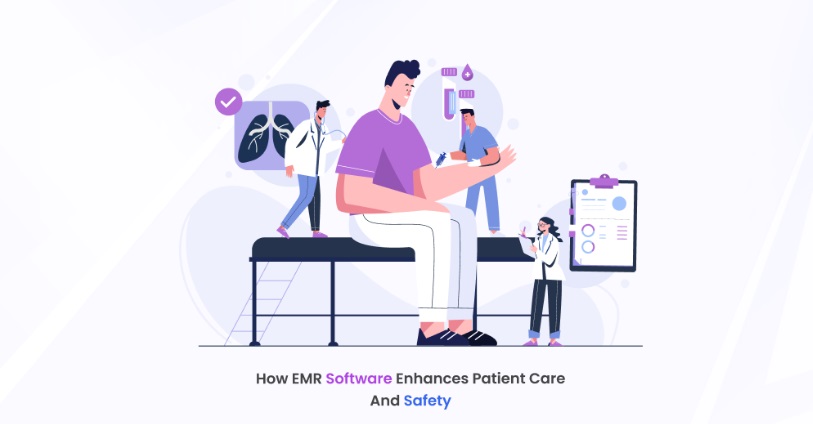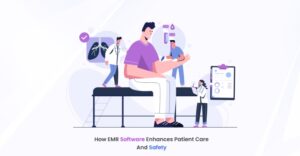
The medical field is one of the sectors that has been affected by technological advancement, and this has been initiated by electronic medical records better known as EMR software. From this outpoint it can, therefore, be deduced that the adoption of EMR software in healthcare facilities has led to phenomenal enhancement of the quality of patient care and safety. This blog focuses on the ways of effective patient care and safety promoted by the use of EMR software, the functions of the electronic health record system software, and the process of EMR software creation.

Understanding EHR and EMR Software
Before going through the various advantages arising from the usage of EHR software and EMR software, it is prudent to define the two. While the terms EHR (Electronic Health Records) and EMR ‘‘software’’ are frequently used synonymously, it is possible to distinguish certain differences in the utility of these systems.
What is EHR Software?
An Electronic Health Record system is an album of a patient’s health in the form of software that is comprehensive, accessible and interoperable across multiple domains of care, which contains all the medical records from the client’s various healthcare providers giving a comprehensive history of the client’s health. EHR Software Development aims to enhance the systems and methods of sharing data across multiple professionals in the medical field and this will have a positive impact on the enhancement of quality services across the health care centers.
Enhancing Patient Care with EMR Software
There are several ways in which the EMR software implementation has helped in the promotion of patient care in healthcare facilities. Here are some of the top benefits of EHR and EMR software in improving patient care: Here are some of the top benefits of EHR and EMR software in improving patient care:
1. Improved Accuracy and Accessibility of Patient Records
Probably, the major advantage of the EMR software is that it facilitates the record keeping of the patient’s details. Whilst on paper there are always mistakes, files get lost, and handwriting is often bad, all of which risks patient safety. EMR software development primarily aims at attaining an efficient management of patient and client information, which is comprehensive up-to-date, and secured for authorized health practitioners.
EMR software makes it easier to learn a patient’s health record summary, lab results, and medications to make appropriate decisions immediately. This accessibility is rather important especially in emergencies when the presence of the patient’s medical history might be rather mandatory.
2. Enhanced Coordination and Continuity of Care
The use of EMR software also helps in the improvement of care, communication, and continuity as it connects healthcare providers. That is because when one individual provider manages to obtain access to another provider’s information concerning a specific patient then the various providers are timely able to coordinate themselves so that they can increase the successful health outcomes of the said patient.
For example, if a patient has been referred to a specialist through the EMR software, the specialist does not need to run a battery of tests on the patient since he/she can see the existing records regarding the patient on the software. Such treatment plans enable the patient to receive appropriate care from different specialists with minimized error risks, which is the core advantage of the concept.
3. Reduction in Medical Errors
It is rather unfortunate that in most healthcare facilities, adverse medical occurrences are common and have dire implications for the lives of the patients. EMR software helps in lowering medical malpractice since it provides comprehensive information about the patients to healthcare practitioners.
For instance, in EMR software, there may be a notification of possible drug interactions or allergies of the patient hence guaranteeing that the patient receives the right treatment. Furthermore, electronic prescribing (e-prescribing) components of the EMR software eliminate errors resulting from a physician’s bad handwriting or a nurse’s misunderstanding of verbal orders.
4. Enhanced Patient Safety
EMR software improves and supports the safety of patients in various areas of their treatment as a result of simplifying work. The notification of healthcare systems aids in monitoring patients’ preventive care treatments like vaccines and tests or any other necessary treatments deserving of patients’ attention.
Also, EMR software has a section where it can recognize adverse events and report them to healthcare organizations, and this would then give patterns for organizations to adopt and reduce the same. For instance, if there is something wrong with a certain drug, it is easy for the health practitioners to search for that problem, and then take requisite measures to avoid mishaps.
5. Improved Patient Engagement and Empowerment
The EMR software is not only constructive for the healthcare providers but, it also enhances the participation of patients in their healthcare systems. These will usually include patient portals and secure messaging options, which allow the patients to go through their records, test results, and Plan of Care from the comfort of their homes.
In addition, patients can use the EMR software to interact with their care providers, ask for script renewal, and set up appointments. It enhances the interactions between patients and their providers and results in high compliance with treatment regimens or improved health status.
The Role of Electronic Health Record System Software
More specifically, the intervention is electronic health record system software by which patient care and safety can be improved. The development of EHR has mainly emphasized effectiveness and compatibility with different healthcare facilities. Here are some key ways EHR software contributes to improved patient care and safety:
1. Comprehensive Health Information
EHR software creates a holistic understanding of a patient’s health information including medical history, known allergies, medications, immunizations, and results of laboratory tests. Thus, the availability of such a broad range of data empowers healthcare industry professionals to make choice-based and patient-centered actions.
2. Interoperability and Data Exchange
A major factor that must be considered while designing EHR software is Interoperability enabling the various healthcare systems to interact and share patient data freely. This capability is most useful when a patient is treated by multiple practitioners or is transferred from one healthcare facility to another.
The authors believe that the implementation of interoperability makes it possible for healthcare providers to obtain the most comprehensive, as well as current information concerning the patient, thereby avoiding mistakes and facilitating proper coordination of care. For example, when a patient needs to be admitted to the hospital, the system pulls out the patient record from the patient’s PCA and makes the admission process easy, the doctor is knowledgeable about the patient’s history.
3. Data Analytics and Population Health Management
EHR systems are also widely used for data analysis and population health interventions. Similarly, I argue that big data in health care assists the healthcare organization in embracing the realization of the continuous and massive accumulation of patient data to uncover existing patterns, vulnerabilities, and adverse health occurrences within the overall patient population.
For example, EHRs allow for evaluating the population of patients with chronic diseases to consider them for enrollment in disease management and effective prevention programs, including screenings. Due to this, actions can be taken proactively to prevent deterioration of the patient’s health hence enhancing the quality of health care and keeping down the costs.
4. Regulatory Compliance and Reporting
The introduction of the EHR software development features enhances the changes of healthcare organizations to meet the required regulations and reporting standards. Such features pertain to auto-documentation, coding suggestions, and reporting features to guarantee that healthcare facilities adhere to the legal requirements.
Hence, concerning the regulations like Health Insurance Portability and Accountability Act (HIPAA), it is necessary to ensure the privacy of patients as well as the security of the received and transferred data. Such regulations are useful in helping healthcare organizations adopt EHR software to avoid the misuse of patient data and increase patients’ trust in hospitals.
EHR Software in India
The implementation of EHR software in India is on the rise. The major care delivery organizations in India realize this as a concept capable of enhancing the health care of patients. A major target of EHR software India activities is developing an interoperable, better health information technology environment that improves care and individual wellness.
Government Initiatives
Many programs have been launched by the Indian government to encourage the use of EHR software throughout the country. One such scheme is the National Digital Health Mission (NDHM) which is expected to develop the setup of digital health identifications, health records, health facilities, and health services.
All rules under the NDHM promote the use of EHR software by the healthcare providers and institutions and connection to the NHIN which would enable the interoperability of the health information. Such measures are believed to create demand for EHR software in India and enhance the outcomes for patients by increasing their safety and the effectiveness of care coordination.
Benefits of EHR Software in India
The implementation of EHR software in India has distinct advantages that include better patient records’ legibility, and accessibility, better communication between Providers, and fewer Medical errors. Moreover, EHR software can resolve such specific problems in the Indian healthcare sector as patients’ fragmentation of care and a lack of access to healthcare services in rural areas.
Also, EHR software can help patients consult and communicate with healthcare providers remotely thus reducing the increase of non-emergency patients going to hospitals as they wait long hours to see a doctor. This capability is highly useful for a country like India as the reach of healthcare facilities is limited in most backward regions.
The Future of EHR and EMR Software Development
There are big expectations for future development of EHR and EMR software, as through adopting new technologies, improvements in the results of patients’ treatment and safety increase. Here are some key trends shaping the future of EHR and EMR software:
1. Artificial Intelligence and Machine Learning
EHR and EMR software have the potential to be transformed by Artificial Intelligence and Machine Learning by bringing predictive analysis, decision support, and, even more, personalized medicine. An array of patient information can be fed into artificial intelligence, which in turn, makes it possible for healthcare turn to check for patterns and possibly predict the overall health of a patient.
For instance, it is possible to identify which patients would be prone to developing chronic diseases hence healthcare services deliver early intervention and customized care. This proactive approach can greatly enhance the level of patient health and decrease the expenses on the provision of healthcare services.
2. Telehealth Integration
The inclusion of telehealth functions into EHR and EMR systems is becoming more relevant including the situation with the COVID-19 pandemic. Telehealth products as clients can be treated through means other than face-to-face appointments and hence are likely to come into contact with infected individuals.
There is an integration of EHR or EMR solutions with telehealth solutions that allow healthcare providers to engage in consultations online and have access to patient’s information as well as record their encounters online. This integration improves the care services for patients and maintains the care process in complex situations.
3. Patient-Centered Design
EHR and EMR software of the future will shift towards involving the patient and designing around the patient. Smart interfaces, mobile availability, and patient graphs will also engage patients in their care processes and decisions.
Further, patient-centered design would be helpful in EHR and EMR software for health care providers to have more time with their patients and decreased bureaucratic loads.
4. Blockchain for Data Security
EHR and EMR software can be secured using blockchain technology as an efficient tool for the sharing of health information. Blockchain offers the possibility of establishing an immutable record of the patient’s data, where such data could be changed by authorized personnel only.
Through proper security measures and privacy algorithms, blockchain can help increase confidence among patients as well as physicians and other providers in using the technologies of EHR and EMR software.
Conclusion
Electronic medical records and electronic health records are some of the most important software in the healthcare system as they improve the accuracy of records, increase access and coordination, and most importantly patient engagement. They are still on the rise and have been bounded by newer progressing areas such as Artificial Intelligence, telehealth, patient-centered technologies, and blockchain.
Since the authorities of healthcare organizations and governments across the globe, including India, have realized the importance of EHR software, its usage is likely to grow, which will positively impact client health and streamline the healthcare sector. The advancement of EMR and EHR software in the future holds the promise to greatly enhance the effective delivery of healthcare services to patients around the world.
Author Profile

- Gaurav Kanabar serves as the Chief Technologist for Digital Content and Platforms at Luckymatrix. Alongside his role at Luckymatrix, Gaurav is CEO of Alphanso Technology, an India-based web and app development company developing an Event management system in PHP and open-source streaming software for helping entrepreneurs, independent artists, and more.
Latest entries
 Digital MarketingApril 8, 2025Manage your website smartly with VPS Servers in Germany
Digital MarketingApril 8, 2025Manage your website smartly with VPS Servers in Germany SoftwareApril 3, 2025Maximize Your Efficiency & Save Time With Free Invoice Software
SoftwareApril 3, 2025Maximize Your Efficiency & Save Time With Free Invoice Software Digital MarketingApril 3, 2025Why Social Media Platforms Benefit from File Upload Features
Digital MarketingApril 3, 2025Why Social Media Platforms Benefit from File Upload Features Digital MarketingApril 3, 2025Top 10 Best Video Animation Companies in Dubai, UAE
Digital MarketingApril 3, 2025Top 10 Best Video Animation Companies in Dubai, UAE